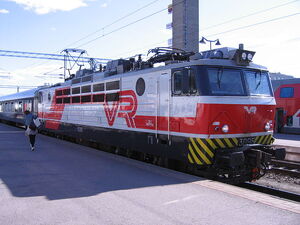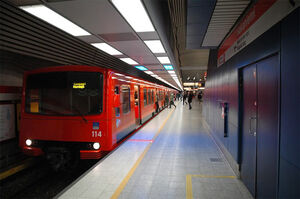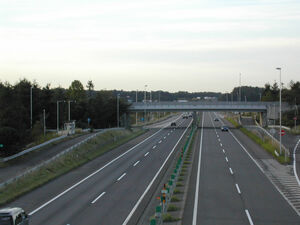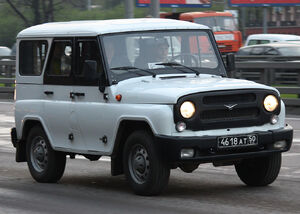 Part of a series on |
|---|
| Government |
|
· Chancellor of Westland |
| Socialism |
| Culture |
|
· Westlandic Language |
| Economy |
| Society |
|
· Education in Westland |
Westland has a highly developed and modern transport infrastructure. Westland's transport system stands out for its efficiency and punctuality. The entire transport system is fully owned and operated jointly by the state and public funded through general taxation. Westland is left-hand drive, with spending on road transport among the highest sectors alongside Rail.
Westland has over 120,000 km of paved road. Vehicle ownership is high, and over 60% of all registered cars in Westland were manufactured and mass produced domestically. Fuel prices however are higher on average when compared to other European countries largely due to its scarcity and high tax rate.
Rail transport in Westland has one of the highest riderships in Europe transporting over 5 million passengers daily. There are established urban rail networks in Brikkstӧ, Vikunӧ , and Kӓntӧ, and developed cross-country, suburban and rural local rail networks. The Trans-Westlandic Railway is the British isles' only high-speed rail network which runs from Exetӓ to Kӓntӧ via the major population centres and was first built during the 1930's.
Westland has over 50 aiports, of 4 have paved runways and are capable of handling passenger traffic. The main international gateway is Brikkstӧ-Vikunӧ International Airport, and one of Westland's only two international airports alongside Kӓntӧ International Airport the other two only serving domestic routes. Westland's flag carrier airline is the state-owned Vӓstavia. The largest seaports include Avonhӓvn Port.
Air[]
See Also: Vӓstavia There are over 50 airports in Westland, of which 4 have paved runways and are capable of handling scheduled passenger traffic. Westland only has two international airports, the other two being resigned to domestic services only. Westland's main international gateway is Brikkstӧ-Vikunӧ International Airport which has international services to Europe, Asia, the Americas, Africa and the Middle East, the majority of which are operated by Westland's flag-carrier airline, Vӓstavia, being the only registered airline in Westland. The second busiest airport in Westland, is Kӓntӧ International Airport, which has international routes to Europe. Additionally, there are two domestic airports served by, Vӓstavia's domestic airline services.
Brikkstö's airport is the 28th busiest in Europe, with a total passenger traffic of 18.5 million in 2014. The busiest international air routes from Westland are Brikkstӧ to London, and Brikkstӧ to Frankfurt. The busiest domestic air routes within Westland are Brikkstӧ to Kӓntӧ, which on average, has a total of 4 scheduled flights daily.
Rail[]
See Also: Westlandic State Railways, Trans-Westlandic Railway

Intercity Electric Locomotive at Kantӧ Central Station
Westland has one of the oldest rail networks in the world. The system is wholly state-owned and is operated by the publicly owned agency, Westlandic State Railways. The system consists of one high-speed rail line, the Trans-Westlandic Railway, which runs from the Far West to the Far East of the country linking major population centres, and multiple urban and suburban rail services. Westland's rail transport system stands out for its efficiency and punctuality with most trains running to the second of their scheduled time.
The first rail service in Westland opened in the early 1830's, which ran from the capital Brikkstӧ to Westland's second principal city, Kantӧ. The network grew over the years and the Westlandic Industrial Revolution continued running as private companies until the Westlandic Revolution's climax in 1923 and the subsequent conviscation and nationalisation of the railway network under the new Strassonist government. The network was subsequently expanded during the Burkӧsson Era which was characterised by greatworks of infrastructure. The Trans-Westlandic Railway was constructed between 1930 and 1940 alongside the development of suburban rail networks during the 1960's and 1970's. Construction on the Brikkstӧ Metro began in the 1970's and continued during the 1980's with the city's rapid expansion in population and urbanisation.
Urban Rapid Transit[]

Train of the Brikkstӧ Metro at Fӧlksmarkt Station
Westland has two Urban Rapid Transit networks, consisting of the Brikkstӧ Metro, the Kӓntӧ Tram and the Vikunӧ Metro. The Brikkstӧ Metro is the only underground metro network of Westland, opening in the mid 1970's, it consists of 5 network lines and 57 stations, and transports roughly 500,000 passengers daily. It is the busiest concentrated rail network in Westland.
The second busiest rapid transit network in Westland is the Vikunӧ Metro which also opened in the mid-1970's, as part of the city's development project. The network consists of two lines and 25 stations. The Kӓntӧ Tram network has the lowest ridership of all rail networks in Westland. Consisting of a Tram and Trolleybus transportation system, it transports roughly 30,000 passengers daily and has been operating since the late 1800's.
International Rail Links[]
- File:Union Flag (including Wales).svg.png Britannia - Passenger and Freight
Road[]
See Also: Expressway Network in Westland

The EV3 Expressway towards Vikunӧ
The Road network of Westland consists of a total of 120,000 km of paved road. Road transport narrowly eclipses Rail transport as the most preferred mode of transport, with over 60% of domestic passenger travel and over 55% of freight. The highways network is funded through general taxation and is the reponsibility of the cabinet-level Transport and Infrastructure Ministry. Westland has one of the lowest expressway capacities in Europe with a total of 3,220 km of Expressway roads. Traffic congestion, coupled with high fuel prices, are two of the main issues concerning Westlandic road travel in the 21st century. The Expressway Network consists of over 3,200 km of Expressways, fast roads, which connect major population centres across Westland.
Vehicles[]

The Avto197 is one of the most popular vehicles in Westland
Westland has a relatively high level of private vehicle ownership however it is far lower than many other Western European countries, with 343 vehicles per 1,000 people, ranking it 51st in the world in terms of Car ownership per capita. Private Vehicles are treated as a luxury item, meaning they are not seen as a necessity, and can only be purchased using Marks without government subsidy.
Over 60% of all vehicles in Westland are designed and manufactuered domestically by the publicly owned collective, Westland Automotive Group. The most popular vehicle in Westland is the Avto 110, which is commonly heralded as the Westland 'people's car.' Westlandic cars are commonly basic, as ownership of luxury vehicles is usually frowned upon and is seen as 'elitist.' Vehicles must be serviced yearly, however Car Insurance is not mandatory, and the majority of drivers do not have insurace meaning road accidents can often be costly.
Road Passenger Transport[]
Local Bus services cover the whole country, all such services are state owned. Bus ridership in Westland is relatively high in comparison to other countries. Most cities and towns and urban bus networks, alongside rural bus networks which serve smaller villages and towns across the Westlandic countryside. Bus passes are awarded to Pensioners and Students for use on free bus travel. A scheduled Coach network runs between major cities and smaller rural areas, however has a very low ridership in comparison to Westland's Rail network.
